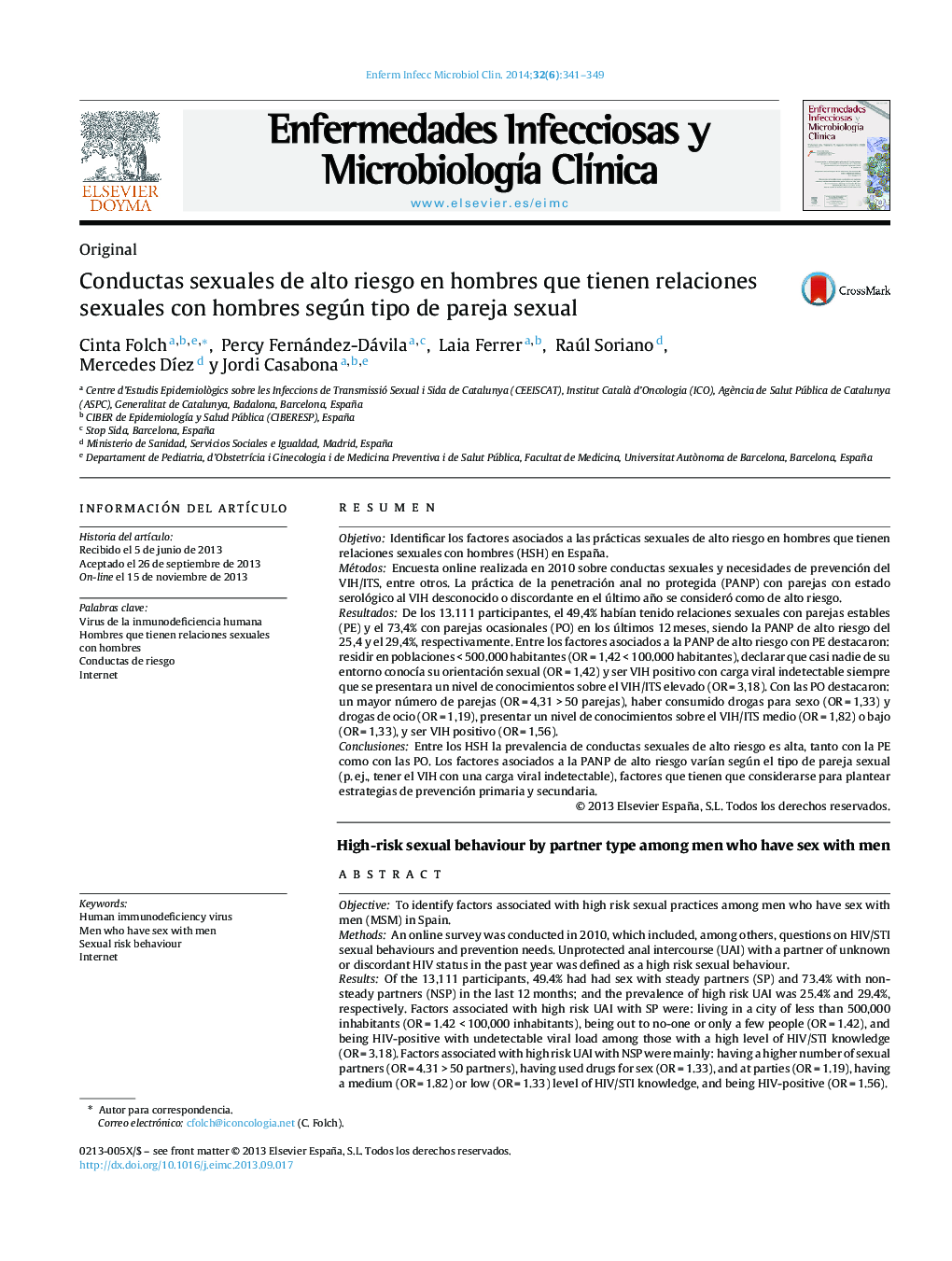| کد مقاله | کد نشریه | سال انتشار | مقاله انگلیسی | نسخه تمام متن |
|---|---|---|---|---|
| 3401256 | 1222656 | 2014 | 9 صفحه PDF | دانلود رایگان |
ResumenObjetivoIdentificar los factores asociados a las prácticas sexuales de alto riesgo en hombres que tienen relaciones sexuales con hombres (HSH) en España.MétodosEncuesta online realizada en 2010 sobre conductas sexuales y necesidades de prevención del VIH/ITS, entre otros. La práctica de la penetración anal no protegida (PANP) con parejas con estado serológico al VIH desconocido o discordante en el último año se consideró como de alto riesgo.ResultadosDe los 13.111 participantes, el 49,4% habían tenido relaciones sexuales con parejas estables (PE) y el 73,4% con parejas ocasionales (PO) en los últimos 12 meses, siendo la PANP de alto riesgo del 25,4 y el 29,4%, respectivamente. Entre los factores asociados a la PANP de alto riesgo con PE destacaron: residir en poblaciones < 500.000 habitantes (OR = 1,42 < 100.000 habitantes), declarar que casi nadie de su entorno conocía su orientación sexual (OR = 1,42) y ser VIH positivo con carga viral indetectable siempre que se presentara un nivel de conocimientos sobre el VIH/ITS elevado (OR = 3,18). Con las PO destacaron: un mayor número de parejas (OR = 4,31 > 50 parejas), haber consumido drogas para sexo (OR = 1,33) y drogas de ocio (OR = 1,19), presentar un nivel de conocimientos sobre el VIH/ITS medio (OR = 1,82) o bajo (OR = 1,33), y ser VIH positivo (OR = 1,56).ConclusionesEntre los HSH la prevalencia de conductas sexuales de alto riesgo es alta, tanto con la PE como con las PO. Los factores asociados a la PANP de alto riesgo varían según el tipo de pareja sexual (p. ej., tener el VIH con una carga viral indetectable), factores que tienen que considerarse para plantear estrategias de prevención primaria y secundaria.
ObjectiveTo identify factors associated with high risk sexual practices among men who have sex with men (MSM) in Spain.MethodsAn online survey was conducted in 2010, which included, among others, questions on HIV/STI sexual behaviours and prevention needs. Unprotected anal intercourse (UAI) with a partner of unknown or discordant HIV status in the past year was defined as a high risk sexual behaviour.ResultsOf the 13,111 participants, 49.4% had had sex with steady partners (SP) and 73.4% with non-steady partners (NSP) in the last 12 months; and the prevalence of high risk UAI was 25.4% and 29.4%, respectively. Factors associated with high risk UAI with SP were: living in a city of less than 500,000 inhabitants (OR = 1.42 < 100,000 inhabitants), being out to no-one or only a few people (OR = 1.42), and being HIV-positive with undetectable viral load among those with a high level of HIV/STI knowledge (OR = 3.18). Factors associated with high risk UAI with NSP were mainly: having a higher number of sexual partners (OR = 4.31 > 50 partners), having used drugs for sex (OR = 1.33), and at parties (OR = 1.19), having a medium (OR = 1.82) or low (OR = 1.33) level of HIV/STI knowledge, and being HIV-positive (OR = 1.56).ConclusionsAmong MSM, the prevalence of high risk sexual practices is high with both SP and NSP. Factors associated with high risk UAI vary by type of sexual partner (e.g., having HIV with an undetectable viral load). These must be taken into account when planning strategies for primary and secondary prevention.
Journal: Enfermedades Infecciosas y Microbiología Clínica - Volume 32, Issue 6, June–July 2014, Pages 341–349
